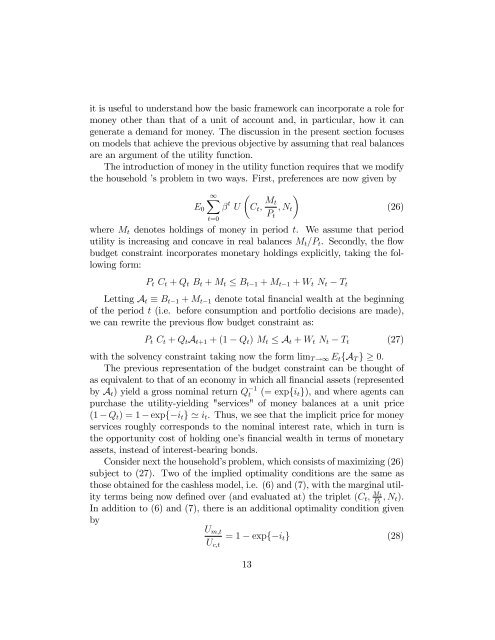Monetary Policy, Inflation, and the Business Cycle Chapter 2 A ...
Monetary Policy, Inflation, and the Business Cycle Chapter 2 A ...
Monetary Policy, Inflation, and the Business Cycle Chapter 2 A ...
Create successful ePaper yourself
Turn your PDF publications into a flip-book with our unique Google optimized e-Paper software.
it is useful to underst<strong>and</strong> how <strong>the</strong> basic framework can incorporate a role for<br />
money o<strong>the</strong>r than that of a unit of account <strong>and</strong>, in particular, how it can<br />
generate a dem<strong>and</strong> for money. The discussion in <strong>the</strong> present section focuses<br />
on models that achieve <strong>the</strong> previous objective by assuming that real balances<br />
are an argument of <strong>the</strong> utility function.<br />
The introduction of money in <strong>the</strong> utility function requires that we modify<br />
<strong>the</strong> household ’s problem in two ways. First, preferences are now given by<br />
E 0<br />
1<br />
X<br />
t=0<br />
t U<br />
<br />
C t ; M t<br />
P t<br />
; N t<br />
<br />
(26)<br />
where M t denotes holdings of money in period t. We assume that period<br />
utility is increasing <strong>and</strong> concave in real balances M t =P t . Secondly, <strong>the</strong> ‡ow<br />
budget constraint incorporates monetary holdings explicitly, taking <strong>the</strong> following<br />
form:<br />
P t C t + Q t B t + M t B t 1 + M t 1 + W t N t T t<br />
Letting A t B t 1 + M t 1 denote total …nancial wealth at <strong>the</strong> beginning<br />
of <strong>the</strong> period t (i.e. before consumption <strong>and</strong> portfolio decisions are made),<br />
we can rewrite <strong>the</strong> previous ‡ow budget constraint as:<br />
P t C t + Q t A t+1 + (1 Q t ) M t A t + W t N t T t (27)<br />
with <strong>the</strong> solvency constraint taking now <strong>the</strong> form lim T !1 E t fA T g 0.<br />
The previous representation of <strong>the</strong> budget constraint can be thought of<br />
as equivalent to that of an economy in which all …nancial assets (represented<br />
by A t ) yield a gross nominal return Qt<br />
1 (= expfi t g), <strong>and</strong> where agents can<br />
purchase <strong>the</strong> utility-yielding "services" of money balances at a unit price<br />
(1 Q t ) = 1 expf i t g ' i t . Thus, we see that <strong>the</strong> implicit price for money<br />
services roughly corresponds to <strong>the</strong> nominal interest rate, which in turn is<br />
<strong>the</strong> opportunity cost of holding one’s …nancial wealth in terms of monetary<br />
assets, instead of interest-bearing bonds.<br />
Consider next <strong>the</strong> household’s problem, which consists of maximizing (26)<br />
subject to (27). Two of <strong>the</strong> implied optimality conditions are <strong>the</strong> same as<br />
those obtained for <strong>the</strong> cashless model, i.e. (6) <strong>and</strong> (7), with <strong>the</strong> marginal utility<br />
terms being now de…ned over (<strong>and</strong> evaluated at) <strong>the</strong> triplet (C t ; Mt<br />
P t<br />
; N t ).<br />
In addition to (6) <strong>and</strong> (7), <strong>the</strong>re is an additional optimality condition given<br />
by<br />
U m;t<br />
U c;t<br />
= 1 expf i t g (28)<br />
13
















